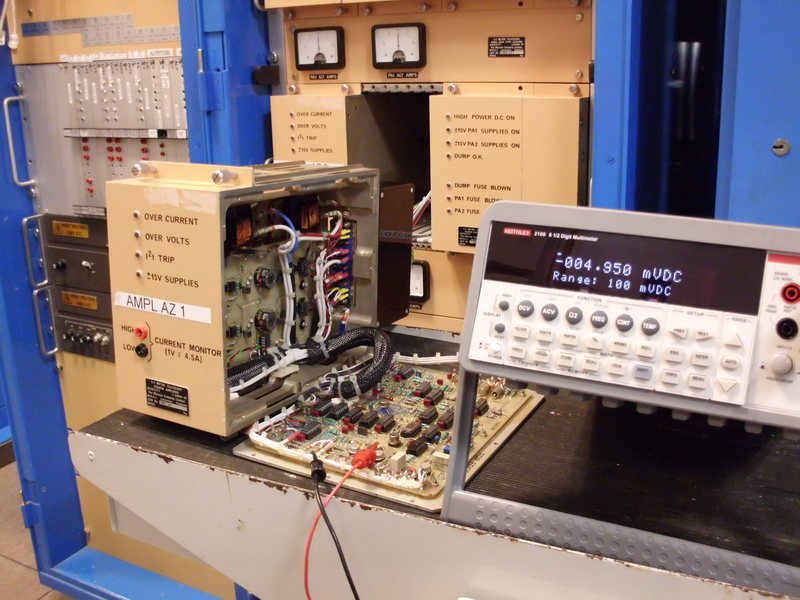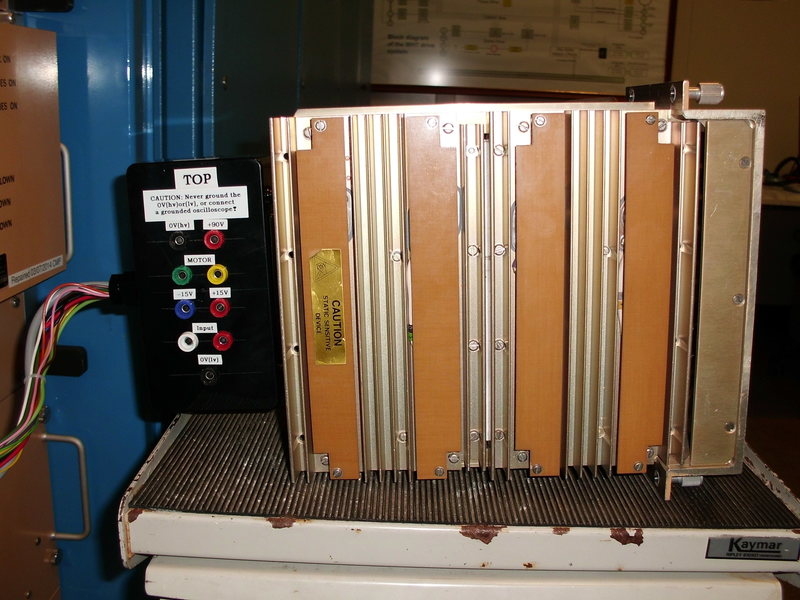Instability in the servo must be distinguished from tracking problems. The most likely cause of a tracking problem which may look like instability is a limit cycle. These can look quite sinusoidal because of the low bandwidth of the telescope response compared to the sampling rate (20Hz) or the velocity loop response (50Hz). They can be caused by a number of faults, but the most likely areas are:
See: Testing the ANALOG PROCESSING board
See: Marconi-APB-component-differences-list.pdf
See: Testing the RATE GENERATOR board


This is the only adjustment that can be made. Re-assemble the P.A. module, and re-insert it into the rack.
n.b. One point to note with offsets: When in Engineering
Mode and with NO demand (velocity control pots fully anti clockwise) and
pushing either the +/- direction buttons, the motor current meters should
NOT give a small kick. If this happens, there is an offset somewhere which
has drifted and needs to be nulled.
The purpose of measuring the Transfer Function of a system is to
determine it's stability. The result can be checked against previous measurements
to determine whether the system parameters have changed. In the unlikely
event that this has happened, appropriate compensation can be calculated
and introduced into the system. Most servo problems which occur with a
system which is known to be stable and properly tuned are the result of
some component failure or non-linearity appearing in the closed loop.
Sometimes the problem can be due to a change in the control system e.g.. increased friction, out of balance torque's, defective couplings and backlash etc. These failures often manifest themselves as Limit Cycles. These are oscillations of the system between two values and can be quite small or extremely large. The system is not unstable in the same sense of linear stability.
Measurements can be made in open loop in order to determine the response in closed loop, but this is not necessary when it is known that the closed loop system is stable. In fact, it is more convenient to make closed loop measurements and plot them on the closed loop coordinates of the Nicholls Chart. This is valid if the system is second order or if the dominant poles of the transfer function are sufficiently Dominant for the system to approximate second order. It is then easy to estimate the compensation necessary to optimise the response. Marconi used this method for on-site tuning of the telescope's axes and other drives. The results are in the Marconi book Tuning Report (at La Palma). This volume is a reference for the performance of the WHT. It also includes autographic records. These are charts of the servo response with time for different velocities, step and ramp functions. These tests would show up things like backlash, increased friction, loss of gain etc.
The Nicholls Chart is a convenient representation of a system's open
loop, closed loop, gain and phase. The open loop response is measured on
the orthogonal grid of phase and gain. The closed loop response uses the
corresponding distorted set of coordinates. The locus of the response is
the frequency axis and is non-linear so plotted points need to be identified
with a frequency. If the locus passes through point 0,0 on the open loop
coordinates or to the left of it when the gain is 0dB or greater, the system
is unstable. The locus should not cross the +3dB closed loop gain circle
as the system would be too under-damped and the settling time too long.
Gain and phase margins are measured on the open loop coordinates from the
point 0,0 to the locus along the corresponding axis. A change in open loop
gain shifts the whole locus up or down the open loop gain axis. Increased
inertia or friction generally tend to push the locus to the left at higher
frequencies. Loops in the locus are the system's resonance and anti-resonance
features. The lowest frequency loop is usually due to the drive compliance
(the anti-resonance is called the Locked Rotor Resonance since this is
the frequency that the load will resonate at when the rotor is locked solid).
Higher frequency loops are structural resonance's feeding back into the
servo.
The generator output of the TFA is connected to the injection point through a suitable resistor so as to preserve unity scaling of input/output signals. The generator output is also connected to channel 1 of the analyser section while the feedback signal is connected to channel 2. The analyser can thus be set to provide direct results by choosing to measure Ch2/Ch1.
In order that system non-linearities do not interfere with the measurement, it is usual to bias the motion of the system and then modulate this with a signal whose amplitude does not null the bias. There are a number of ways of doing this, but the preferred method is now described.
An oscilloscope is connected to the Tacho signal in order the monitor the behaviour of the drive and ensure that the drive does not reverse or saturate on application of the disturbance signal.
For this test the bias is applied via the control computer since any bias applied by the generator would be counteracted by the action of the servo trying to maintain position. A battle which bias cannot win! It is also necessary that the telescope is operated in Computer Mode so that anti-backlash torque is applied.
The drive can now be set up to slew at a constant lowish speed by modifying the software velocity limit to a low value and then slewing to a position far enough away to allow time for the measurement to be made. The change to the velocity limit is made using GSEXAM and is described later.
With the drive slewing slowly, the stimulus or disturbance can be applied in small increments until a desirable level is reached nb. The response will vary with frequency and a check must be made at each measurement that the bias is not being nulled by a high signal or that the response is so low as to cause problems for the correlator in the analyser section of the TFA.
A suitable integration time should be chosen such that results are consistent. This depends on the S/N of the response and the linearity of the system under test. On the WHT, an integration over 10 cycles has found to be adequate.
On the INT an integration of 100 cycles may be required although this is tedious at 0.1Hz. n.b. This probably does not apply now as the INT now uses a WHT style TCS.
WARNING
Care must be taken not to over-excite the system under test as this
can cause damage let alone produce meaningless results. The stimulus should
be kept small. Care with entering the amplitude and frequency parameters
is needed and a close watch kept on the Tacho so as to avoid problems with
resonance's of the system.
The position loop is a Type 2 control system i.e. A system with two pure integration's; one in the counter the other is the electronic integrator on the PRB. Hence the low frequency response will be asymptotic to the -180 degree open loop phase line. A departure from this indicates that the input resistors to the summing point are not matched. The locus should then sweep around the plug-hole in the middle, just grazing the 2dB contour at the highest frequency point possible before diverting into resonance loops.
n.b. A compromise has to be accepted in azimuth because of changing tube inertia with elevation. Thus two plots are made; one for the tube vertical and one for the tube at AP1. The closed loop bandwidth (at the -3dB contour is about 2.5Hz for azimuth and elevation.
The velocity loop is a Type 1 control system and thus the l.f. locus will be asymptotic with the -90 degree line. The closed loop bandwidth is about 25Hz for azimuth and elevation.
The Marconi PRB has the compensation networks on board so that re-tuning
is a matter of simply introducing or changing components once the desired
compensation has been calculated.
MEC_AR_DAT(2).LIMIT.VEL
The value will be displayed in the upper window. The mechanism code in brackets refers to the axis.
To change a value use the deposit command. e.g.. To limit the altitude axis velocity to one hundredth of it's normal rate type:
MEC_AR_DAT(1).LIMIT.VEL = 1.745E-04
You can use examine to check the range. nb. The value is only changed in the Global Section for the duration of that TCS login. When the TCS is re-booted the value is re-initialised.
The Tuning Report describes these and how they are made. Simply
connect the chart recorder, set up the velocity using the test box or GSEXAM
and start recording. For a step response, you set up the required velocity,
start the chart and then slew the telescope and stop the telescope. An
indication of how well the telescope servos is
given by the error at standstill. For azimuth and elevation this is usually
+/- 1 bit, but for the rotators with the higher friction, it can be a lot
more.
Basic closed loop performance can be checked using the Marconi Test Box. This eliminates the Rate Generator and also the computer closed position loop i.e. In particular a faulty CAMAC encoder module. Gross oscillation of the telescope sometimes occurs on start-up and may be the result of the anti-backlash bias switching on too fast, a power amplifier coming on late or the brake sticking on a drive motor shaft. Switching power amplifiers on when already in Computer Mode nearly always induces this oscillation!
Telescope glitches are a phenomenon not understood. They usually occur in azimuth and are most likely due to a digital fault. If they become frequent, the test box could be used to track the telescope in azimuth (with a certain amount of manual dexterity) on a star. This might eliminate the major part of the Marconi electronics.